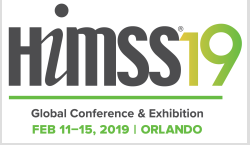HIMSS
See the following -
Industry Groups To Congress: 4 Ways To Prioritize Telehealth
A cadre of healthcare industry associations has called on Congress to prioritize telehealth and remote monitoring...
- Login to post comments
Lessons Learned from the SSA NHIN Project
One of the most high-profile ARRA NHIN contracts, the Social Security Administration's (SSA) effort to gather medical evidence in support of disability claims over the Nationwide Health Information Network (NHIN) and expand the Exchange's Participant list to a more national coverage is finally realizing tangible results as a number of contractors have moved their systems into go-live production state.
- Login to post comments
Mario Hyland Makes The Case For Continuous Interoperability
 Interoperability has been a key buzz word heard along the road toward modernizing the American healthcare system. But standards, conformance to those standards, and thorough testing to ensure conformance are all required to achieve true, seamless information exchange. That’s the message advocated by Mario Hyland, senior vice president and founder of AEGIS, a consulting firm focused on advancing a health IT testing infrastructure. Hyland spoke with Clinical Innovation + Technology about current interoperability and testing challenges.
Interoperability has been a key buzz word heard along the road toward modernizing the American healthcare system. But standards, conformance to those standards, and thorough testing to ensure conformance are all required to achieve true, seamless information exchange. That’s the message advocated by Mario Hyland, senior vice president and founder of AEGIS, a consulting firm focused on advancing a health IT testing infrastructure. Hyland spoke with Clinical Innovation + Technology about current interoperability and testing challenges.
- Login to post comments
Meaningful Use of EHRs Stage 2: What to Expect in the Proposed Rules
There will be many blogs and news reports, on Health Affairs Blog and elsewhere, about the very-soon-to-be-released Stage 2 proposed rules on the Meaningful Use of electronic health records (EHRs). This report is more impressionistic. Read More »
- Login to post comments
Meaningful Use Stage 2 NPRM Means New Opportunities for Medical Device and Non-traditional Health IT Vendors
...Meaningful Use Stage 1 was mostly about setting the bare minimum electronic health record functional requirements and pegging a “floor” for data capture; it had many required elements a few optional elements for care providers to utilize (but vendors had to make even the optional functionality available for use). Read More »
- Login to post comments
MHS, Navy CIOs Open Up About iEHR
In a surprisingly frank conversation about iEHR, CIOs of the Military Health System and the U.S. Navy offered a glimpse into how their organization makes large IT decisions, most notably concerning the EHR it is looking to acquire. Read More »
- Login to post comments
National Patient Data Matching Strategy: Algorithm Challenge
The announcement last week that ONC will be launching a Patient Matching Algorithm Challenge is the next big step in the health IT community’s efforts to ensure patient safety through advancements in interoperability. As a community, we’ve been working on the patient data matching issue for many years. HIMSS has worked very closely with our friends across the healthcare community to understand the barriers to accurate, efficient matching of patients to their health information...
- Login to post comments
New Consulting Company Exsede Brings Unparalleled Expertise To Meet Critical Demand For Healthcare IT
New Consulting Company Exsede Brings Unparalleled Expertise to Meet Critical Demand for Healthcare IT Read More »
ONC fail: EHR 'data blocking' still rampant
Manuel Prado, president of Viva Transcription, Santa Cruz, Calif., publicly complained two years ago about the high interface fees – up to $10,000 – that electronic health record vendors charged for each hospital or physician practice they connect to his transcription service. “That's data blocking,” he charged. “If taxpayers are contributing $44,000 or $63,000 (in federal Medicare and Medicaid incentive payments) for each EHR, it's not too much to ask” that they make interconnect charges free.
- Login to post comments
Open Health Guide to HIMSS19
 The annual gargantuan HIMSS conference is back in Orlando with over 45,000 participants from more than 90 countries. There will be more than 1,300 vendors at the exhibit floor and more than 300 educational sessions. As with the last several conferences, the focus on open source as the key underlying technologies of health information technologies continues to increase. In previous conferences, we have seen the rise of open source technologies, in particular, those related to interoperability such as FHIR and Blockchain. A large number of sessions at HIMSS19 will be focused on another set of technologies powered largely by open source software and design principles such as artificial intelligence (AI), machine learning, and natural language processing.
The annual gargantuan HIMSS conference is back in Orlando with over 45,000 participants from more than 90 countries. There will be more than 1,300 vendors at the exhibit floor and more than 300 educational sessions. As with the last several conferences, the focus on open source as the key underlying technologies of health information technologies continues to increase. In previous conferences, we have seen the rise of open source technologies, in particular, those related to interoperability such as FHIR and Blockchain. A large number of sessions at HIMSS19 will be focused on another set of technologies powered largely by open source software and design principles such as artificial intelligence (AI), machine learning, and natural language processing.
- The Future Is Open
- Login to post comments
Patient-Centered Security Program
 Andy OramThe HIMSS report certainly appears comprehensive to a traditional security professional.They ask about important things–encryption, multi-factor authentication, intrusion detection, audits–and warn the industry of breaches caused by skimping on such things. But before we spend several billion dollars patching the existing system, let’s step back and ask what our priorities are. It’s a long-held tenet of the security field that the most common source of breaches is internal: employees who were malicious themselves, or who mistakenly let intruders in through phishing attacks or other exploits. That’s why (you might notice) I don’t use the term “cybersecurity” in this article, even though it’s part of the title of the HIMSS report.
Andy OramThe HIMSS report certainly appears comprehensive to a traditional security professional.They ask about important things–encryption, multi-factor authentication, intrusion detection, audits–and warn the industry of breaches caused by skimping on such things. But before we spend several billion dollars patching the existing system, let’s step back and ask what our priorities are. It’s a long-held tenet of the security field that the most common source of breaches is internal: employees who were malicious themselves, or who mistakenly let intruders in through phishing attacks or other exploits. That’s why (you might notice) I don’t use the term “cybersecurity” in this article, even though it’s part of the title of the HIMSS report.
- Login to post comments
Patient-Centered Security Program (Part 2)
 Andy Oram
Andy Oram
The previous part of this article laid down a basic premise that the purpose of security isto protect people, not computer systems or data. Let’s continue our exploration of internal threats. This is a policy issue that calls for involvement by a wide range of actors throughout society, of course. Policy-makers have apparently already decided that it is socially beneficial–or at least the most feasible course economically–for clinicians to share data with partners helping them with treatment, operations, or payment. There are even rules now requiring those partners to protect the data. Policy-makers have further decided that de-identified data sharing is beneficial to help researchers and even companies using it to sell more treatments.
- Login to post comments
Providers 'Grappling' With Mobile Plans
Everybody uses mobile devices, but no one is still quite sure how to make the most of them. That, to varying degrees of more-or-lessness, is the upshot of the most recent HIMSS Analytics Mobile Technology Survey, which for the past three years has taken the pulse of an industry still coming to terms with the benefits and risks of mobile technology...
- Login to post comments
Senator's Call For Reboot Of EHR Incentive Program Evokes Responses
The recent white paper released by six Republican Senators assessing federal progress promoting health information technology adoption and standards asked for reader feedback, and the healthcare industry responded. Read More »
- Login to post comments
The 5-Year Plan: Where Will Healthcare Be in 2017?
The next few years represent a tipping point. Open-source collaboration, semantic technologies, universal exchange languages will lead to a new era of interoperability, says Hamilton, enabling system-wide advances in how data is put to use. "Once we start talking the same language, we can compare like things and develop quality indicators. If that happens, costs will go down and quality should improve."
- Login to post comments